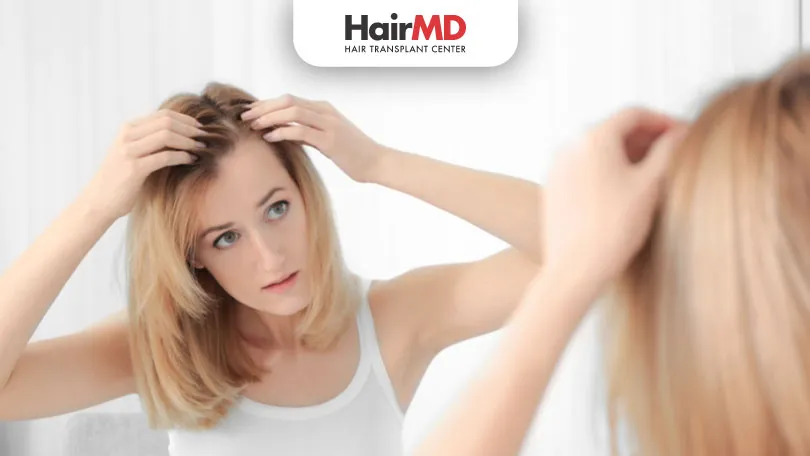7th Sep, 2022

Hair loss is a distressing condition where many of us can find ourselves helpless and hopeless. We at Hair MD understand the way you feel when you see your hair in clumps every day. But don’t fret; you are not alone. Studies and statistics reveal that approximately 85% of adult males and more than 50% of women experience hair loss and hair thinning in India. Several studies have demonstrated that identifying the type of hair loss can help in reversing or halting baldness effectively.
Female pattern hair loss (FPHL), also called androgenetic alopecia, is women’s most common type of alopecia (hair loss). It affects approximately 30% of all susceptible women, most commonly seen after menopause. It is seen as the gradual thinning of the hair over the top of your head, noticed as a widening of the partition or increase in visibility of the scalp.
What’s covered in the article?
- What Causes Female Pattern Hair Loss?
- What are the Symptoms of Female Pattern Hair Loss?
- What are the Types of Hair Loss in Females?
- How can Female Pattern Hair Loss be Treated?
- Conclusion
What Causes Female Pattern Hair Loss?
Female pattern baldness is not due to some vitamin deficiency, poor blood circulation, dandruff, or wearing hats. Each strand of hair sprouts from a tiny hole in the skin called a follicle. In general, baldness occurs when the hair follicles shrink over time, causing shorter and thinner hair. Eventually, the follicles shrink completely and stop producing new hair. However, the follicles remain alive, suggesting that it is still possible to grow new hair over time.
The reason for female pattern baldness can be attributed to:
- Ageing
- Changes in the levels of androgens (hormones that stimulate male features)
- Family history of male or female pattern baldness
- Heavy loss of blood during monthly periods
- Certain medicines, such as oral contraceptives
What are the Symptoms of Female Pattern Hair Loss?
Are you seeing noticeable areas of thin or missing hair, mainly on the top of your head, that you can see scalp skin through or is your hair partition getting wider?
Hair thinning in females is different from that seen in male pattern baldness. In female pattern baldness, hair loss is seen mainly in the front of the head and the crown. It is usually seen in the initial stages as widening of the hair part. The front hairline remains unaffected except for normal recession, which happens to everyone with the passage of time. The hair loss rarely progresses to total or near-total baldness, as it may be the case in men.
What are the Types of Hair Loss in Females?
There are primarily four types of diffuse hair loss seen in females: telogen effluvium, androgenetic alopecia, anagen effluvium, and involutional alopecia.
1. Telogen Effluvium is a temporary hair loss issue caused due to excessive hair shedding. Physical trauma, excessive stress, nutritional deficiencies, weight loss, medical illnesses, childbirth, and surgeries generally cause this sudden hair loss. It occurs when a large percentage of hair follicles suddenly get into the resting phase prematurely.
2. Androgenetic Alopecia, or female pattern baldness, is the most common hair loss and is caused by genetics or family history. It generally begins between the ages of 12 to 40 years old. Over time, your hair starts thinning at the crown, often resulting in partial or complete baldness.
3. Anagen Effluvium is caused by medications that disrupt a growing hair follicle. It is generally due to certain medical conditions and can be regained in 1-3 months.
4. Involutional Alopecia is yet another common and natural hair loss issue. As age progresses, your hair follicles begin to lose their regrowth potential; this process causes gradual hair thinning with age, making the hair short, thin, and prone to breakage.
How can Female Pattern Hair Loss be Treated?
There are several potential treatments and medications for hair loss caused by female-pattern baldness. Your dermatologist may recommend one or a combination of treatments for months or years to see the full results.
- Applying 2% minoxidil solution to the scalp every day may help slow down the progression and partially restore hair in some females. Minoxidil solution should be applied to the affected scalp or roots of the hair using a dropper or pump spray device and should be spread over the affected area gently; it does not need to be massaged in. Minoxidil should be used for at least 6 months before any substantial benefit can be noticed. Any benefit will last for as long as the treatment is used. Minoxidil solution may cause an initial hair fall in the first 2-8 weeks of treatment, which usually subsides when the new hair grows.
- Hormonal replacement therapy is sometimes used to treat menopausal symptoms and to provide protection from chronic hair fall for which postmenopausal women may be at risk due to hormone imbalances. These hormones, available in estrogen and progesterone, pills, and patches, can help prevent hair loss as well as ease menopause symptoms.
- Platelet-rich plasma (PRP) is a treatment that is increasingly used to accelerate healing cases of androgenic alopecia, a common condition that causes hair follicles to shrink. It may help restore hair growth.
- A Hair Transplant can also be effective in females who do not respond well to medical treatment or have not shown significant cosmetic improvement. During a hair transplant, tiny plugs of hair are removed from areas where hair is thicker and placed (transplanted) in areas that have become bald. Minor scarring may occur in the areas where the hair is removed.
- Hair weaving, hairpieces, or a change in hairstyle can also help hide hair loss and hone your appearance. This is most often the safest way to deal with female pattern baldness.
- Many patients who face hair loss also seek options to hide or reduce the appearance of hair loss with hair prostheses (wigs, hairpieces, and extensions) or hair camouflaging agents (hair fibres, powder cakes, lotions, sprays, hair crayons, and scalp tattooing).
Female pattern baldness can be distressing and affect a person’s self-confidence and self-image. Women who experience excessive hair loss should talk with their dermatologist, who can help determine the cause and best treatment option. A timely diagnosis can help a person develop a treatment plan that prevents further hair loss and help restore hair growth.
Are you ready to say goodbye to hair loss? Book your appointment with HairMD today!
Do You Know?
Nearly 250 Patients Visit HairMD
Everyday For Various Hair Concerns?
(You are one click away from flawless skin)
Meet Our Dermatologists
Conclusion
In conclusion, female pattern hair loss can be challenging, but it’s not something you have to face alone. With the right diagnosis and treatment options, it is possible to manage and even reverse hair loss. From medications to hair transplants, there are many ways to restore hair growth and confidence.
If you’re struggling with hair loss, don’t hesitate to reach out to a specialist who can guide you on the best treatment plan. Take the first step today and start your journey toward healthier hair!
Further Reading
पुरुषां मध्ये टक्कल पडण्याची कारणे व उपचार (Male Pattern Baldness)
पुरुषांमध्ये टक्कल पडण्याची कारणे आणि प्रभावी उपचार जाणून घ्या!
Why Men Experience Baldness: A Comprehensive Guide
Discover why men go bald and explore top reasons for hair loss. Learn effective management and treatment options for male hair loss.
Home Remedies vs. Specialist Treatments for Baldness: What Works Best?
Discover how Irinotecan affects hair loss, why it happens, and what you can do about it.
How to Prevent Baldness? : Tips for Both Men and Women
Learn practical tips to prevent baldness and maintain healthy hair for both men and women.
Have thoughts? Please let us know
We are committed not only to treating you, but also educating you.











